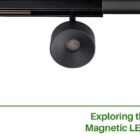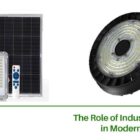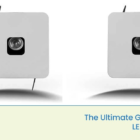Defining the Significance of Industrial LED Lights
In modern-day manufacturing, the importance of industrial LED lighting should be emphasized. These powerful illuminators have become essential components in factories across the globe and have revolutionized the way businesses take on lighting solutions. As we strive for greater efficiency, sustainability, and optimal working conditions, Industrial LED lights are the mainstay of modernity.
Industrial LED lights play an essential role in meeting the ever-changing lighting requirements of modern industrial environments. Their value lies in their capacity to offer sufficient illumination and their ability to achieve this with remarkable energy efficiency. As the manufacturing industry constantly seeks ways to decrease its environmental footprint and operational expenses, introducing industrial LED lighting has proved revolutionary.
Overview of Modern Manufacturing Lighting Needs
Manufacturers, realizing the need for lighting solutions compatible with environmental and economic goals, have shifted toward LED lighting technology. This trend is driven by the numerous advantages industrial LED lights provide. They have a longer lifespan than conventional lighting systems and a robustness that can withstand the demands of industrial environments. These lights offer not just instant cost savings but also long-term reliability.
Additionally, the choice of industrial LED lights is a commitment to sustainability. LED technology is energy efficient, resulting in less power consumption, reducing carbon emissions, and contributing to an eco-friendly manufacturing environment.
Evolution of Lighting in Manufacturing

The evolution of lighting in manufacturing is a tale that spans centuries and traces the evolution of technology and changes in society. From the beginning of incandescent bulbs putting out an inviting glow over factory floors to the current modern era, dominated by the latest industrial LED lights, the journey is an unending determination to improve safety, efficiency, and sustainable development.
Historical Perspective
From a historical perspective, introducing artificial lighting manufacturing was an unimaginable shift from the dependence on natural lighting. The Industrial Revolution saw the rise of incandescent lights, allowing workers to extend work hours and work round the clock. The light of these early lights not only lit up production processes but was a symbol of progress and productivity.
Shift Towards Energy Efficiency
However, as the growth of industries increased and energy conservation gained greater importance, a massive shift took place–a shift to energy efficiency. The limitations of conventional lighting systems were revealed, leading to the search for alternative solutions that would provide better illumination and lower energy usage. This resulted in the rise of industrial LED lighting.
Industrial LED lights became the torchbearers of a brand new generation of lighting for manufacturing. This change was motivated by the desire for more light-filled spaces and an effort to reduce environmental and energy costs. LED technology’s innate efficiency–converting a higher percentage of electrical energy into visible light–marked a departure from the wasteful energy conversion of conventional bulbs.
Advantages of Industrial LED Lights
The widespread use of industrial LED lights for manufacturing is rooted in a trifecta of compelling benefits: energy efficiency, longevity, and sustainability. These fundamentals address the immediate requirements of manufacturing companies and connect with the larger ecological and economic demands.
Energy Efficiency and Cost Savings
One of the most notable advantages is the incredible effectiveness of the energy used by industrial LED lights. In contrast to traditional lighting systems, which emit a large portion of energy in heat, LED technology is superior in converting a greater proportion of electrical energy into visible light. This efficiency translates into more intense and bright lighting and significantly saves companies energy. In a time when energy conservation is both a moral and an economic necessity, industrial LED lights are seen as a symbol of responsible use of energy.
Longevity and Durability
The durability and longevity of industrial LED lights are an enormous shift in the maintenance of factories. Unlike fluorescent and incandescent equivalents, LED lights have an incredible operational lifespan. This extends the life of lights and reduces the need for replacements but also minimizes the environmental impact of manufacturing because fewer resources are utilized for manufacturing replacement units. When working in harsh environments where reliability is crucial, the durability of LED lights guarantees consistent and long-lasting performance, improving operational efficiency.Environmental Impact and Sustainability

Additionally, industrial LED lights are a sign of the commitment to sustainable development and environmental stewardship. They have a much lower carbon footprint than traditional light sources; LED technology aligns with the efforts of all nations to reduce the effects of climate change. The lower energy consumption of LEDs reduces greenhouse gas emissions and positions manufacturing facilities as a key contributor to a greener, sustainable future.
Technological Innovations in Industrial LED Lighting
The field of industrial LED lighting is experiencing an evolution in technology, pushing lighting beyond the traditional to become a vital part of the intelligent manufacturing landscape. The latest technological advances in this field have changed how manufacturers consider lighting and introduced capabilities beyond basic luminosity.
Smart Lighting Systems
A significant improvement is the incorporation of intelligent lighting systems. Industrial LED light systems with intelligent controls can adjust dynamically to factors like lighting levels, occupancy, and even the times of the day. This improves energy efficiency, as it ensures that lights only turn on at times of need and creates an improved and more responsive workplace. Motion sensors and sophisticated control systems signal a time that sees lighting becoming a vital element of the manufacturing process.
Integration with IoT and Industry 4.0
Integrating industrial LED lighting with the Internet of Things (IoT) and Industry 4.0 represents another groundbreaking technological leap. By integrating lighting systems into the larger system of connected devices, companies can collect valuable information on energy consumption, occupancy patterns, and employee preferences.
This method of data-driven design can lead to proactive maintenance, improved energy consumption, and increased overall efficiency. The interaction between industrial LED lighting and IoT technologies exemplifies the connected and intelligent manufacturing future.
Customization and Adaptive Lighting
The ability to customize and adaptive lighting solutions represents yet another leap in technological innovation. Industrial LED lighting allows tailoring lighting conditions to the specific task to create a working environment that improves workers’ comfort and efficiency. Different color temperatures, levels of brightness, and even tunable lighting profiles add to an environment that can be adapted to various manufacturing processes.
This flexibility creates an aesthetically pleasing and relaxing working environment and highlights the potential for industrial LED lights to satisfy the various demands of modern-day manufacturing.
Considerations for Implementing Industrial LED Lights
Implementing industrial LED lights in industrial settings requires a deliberate method beyond simply replacing conventional lighting systems. Several important considerations are brought into the equation to ensure a seamless integration that increases efficiency, longevity, and conformity with the industry standards.
Choosing the Right Lighting Solution
The right lighting system is the key to an efficient implementation. Manufacturers should take the time to evaluate their facilities’ requirements while considering the nature of the job, the spatial requirements, and any specific lighting requirements.
Customization options offered by industrial LED lighting, like adjustable color temperatures and lighting profiles, should align with the specific tasks performed across different facility locations. The right balance between brightness, color accuracy, and energy efficacy is essential to achieve the best outcomes.
Installation and Maintenance Tips
Additionally, industrial LED lights are a sign of the commitment to sustainable development and environmental stewardship. They have a much lower carbon footprint than traditional light sources; LED technology aligns with the efforts of all nations to reduce the effects of climate change. The lower energy consumption of LEDs reduces greenhouse gas emissions and positions manufacturing facilities as a key contributor to a greener, sustainable future.
Technological Innovations in Industrial LED Lighting
The field of industrial LED lighting is experiencing an evolution in technology, pushing lighting beyond the traditional to become a vital part of the intelligent manufacturing landscape. The latest technological advances in this field have changed how manufacturers consider lighting and introduced capabilities beyond basic luminosity.
Smart Lighting Systems
A significant improvement is the incorporation of intelligent lighting systems. Industrial LED light systems with intelligent controls can adjust dynamically to factors like lighting levels, occupancy, and even the times of the day. This improves energy efficiency, as it ensures that lights only turn on at times of need and creates an improved and more responsive workplace. Motion sensors and sophisticated control systems signal a time that sees lighting becoming a vital element of the manufacturing process.
Integration with IoT and Industry 4.0
Integrating industrial LED lighting with the Internet of Things (IoT) and Industry 4.0 represents another groundbreaking technological leap. By integrating lighting systems into the larger system of connected devices, companies can collect valuable information on energy consumption, occupancy patterns, and employee preferences.
This method of data-driven design can lead to proactive maintenance, improved energy consumption, and increased overall efficiency. The interaction between industrial LED lighting and IoT technologies exemplifies the connected and intelligent manufacturing future.
Customization and Adaptive Lighting
The ability to customize and adaptive lighting solutions represents yet another leap in technological innovation. Industrial LED lighting allows tailoring lighting conditions to the specific task to create a working environment that improves workers’ comfort and efficiency. Different color temperatures, levels of brightness, and even tunable lighting profiles add to an environment that can be adapted to various manufacturing processes.
This flexibility creates an aesthetically pleasing and relaxing working environment and highlights the potential for industrial LED lights to satisfy the various demands of modern-day manufacturing.
Considerations for Implementing Industrial LED Lights
Implementing industrial LED lights in industrial settings requires a deliberate method beyond simply replacing conventional lighting systems. Several important considerations are brought into the equation to ensure a seamless integration that increases efficiency, longevity, and conformity with the industry standards.
Choosing the Right Lighting Solution
The right lighting system is the key to an efficient implementation. Manufacturers should take the time to evaluate their facilities’ requirements while considering the nature of the job, the spatial requirements, and any specific lighting requirements.
Customization options offered by industrial LED lighting, like adjustable color temperatures and lighting profiles, should align with the specific tasks performed across different facility locations. The right balance between brightness, color accuracy, and energy efficacy is essential to achieve the best outcomes.
Installation and Maintenance Tips

The installation process is equally vital and requires careful planning and implementation. The proper placement of industrial LED lights ensures uniform illumination throughout the work area while minimizing shadows and improving visibility. Working with lighting experts in the process of installation can aid in solving specific problems specific to each manufacturing setting and improve the overall efficiency of the lighting system using LEDs.
Maintenance is crucial in the long-term viability of lighting solutions for industrial applications. Although LED lighting is renowned for its long-lasting performance, regular maintenance is vital to ensure it meets the highest performance standards. Regular cleaning to eliminate dirt and dust and prompt replacement of defective components will ensure consistent and efficient operation. Manufacturers must develop a regular maintenance program compatible with the demands of their facilities.
Regulatory Compliance and Standards
Moreover, adherence to industry standards and regulatory compliance is not negotiable. Manufacturers should ensure that their selected industrial LED lights meet the relevant quality and safety standards, ensuring security and a reliable lighting environment. Being aware of any modifications to the regulations will ensure that they are in compliance and reduce the risk that arises from non-conforming lighting solutions.
Challenges and Solutions
Although using industrial LED lights in manufacturing can bring many benefits, it’s challenging. Understanding and tackling these issues is vital to successfully adopting the latest lighting technology.
Addressing Common Issues
Resolving common problems is an important step towards ensuring that the integration of industrial LED lights is seamless. The most frequent issue is the initial cost, which can seem higher than conventional lighting systems. However, manufacturers need to consider it a long-term investment that will yield a significant return on energy savings, lower maintenance costs, and increased operational efficiency. The long-term benefits of this investment can ease initial budgetary concerns.
Another problem is ensuring even illumination throughout vast manufacturing areas. Improperly placed or poorly dispersed LED fixtures could result in uneven lighting, shadows, and reduced visibility. Working with experts in lighting in the design and installation stages helps to avoid these problems by ensuring that the industrial LED fixtures are located to provide the best coverage.
Resistance to change can be a frequent obstacle when implementing a new technology, and industrial LED lighting is no exception. People used to conventional lighting systems might be reluctant to accept the change. The benefits of LED technology, like increased visibility, less eye strain, and a more relaxing working environment, can ease concerns. Offering training and support throughout the transition can help increase the positive effect of the changes and encourage adjusting to it more smoothly.
Overcoming Resistance to Change
The process of overcoming resistance to change requires addressing any misperceptions regarding the environmental impacts of industrial LED lighting. Many may be concerned about removing LED fixtures based on the electronic elements they contain. Highlighting the green aspects of LED lighting, which include lower energy consumption and less carbon emissions, can help alleviate these worries and demonstrate the importance of sustainable development.
Future Trends in Industrial LED Lighting

The future of industrial LED lighting has exciting possibilities, driven by a new wave of technologies that are set to revolutionize lighting production. In a world where industries continue to emphasize efficiency, sustainability, and technology integration, the trajectory of industrial LED lights is toward innovation and flexibility.
Emerging Technologies
One of the most important trends shaping our future is integrating and using sensor technology with lighting systems for industrial use. Advanced sensors, like ambient light detectors and occupancy sensors, will create intelligent lighting solutions that react rapidly to the changing requirements of the industrial setting. This can improve energy efficiency by ensuring lights are only activated when needed and creating an improved safety and efficient workspace.
In addition, advancing systems connected within Industry 4.0 will extend its impact on industrial LED lighting. Integrating with the Internet of Things (IoT) will facilitate seamless communications between lighting systems and other smart devices within the manufacturing system. This connected approach enables the use of data-driven decisions as well as predictive maintenance and the improvement of lighting conditions by specific manufacturing processes.
Anticipated Developments in Manufacturing Illumination
The anticipated developments in manufacturing illumination will also offer enhanced options for customization. The future of industrial LED lights will likely feature more sophisticated control options, allowing companies to alter lighting conditions more precisely. Color levels, temperatures, and lighting profiles can be more advanced, creating an adjustable lighting environment that improves productivity and employee well-being.
Additionally, studying new manufacturing methods and materials can aid in developing more sustainable and efficient Lighting solutions using LEDs. The advancements in materials science could result in the creation of greater efficiency LEDs, which will pave the way to brighter and more energy-efficient illumination.
Conclusion
Industrial LED lights revolutionize manufacturing with unparalleled effectiveness, durability, and sustainability. As they develop with the latest technologies, they serve as beacons, leading industries to a brighter, more efficient, greener, and smarter future.




